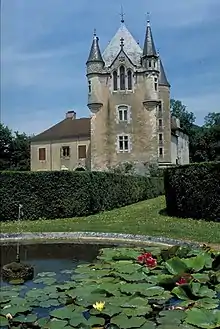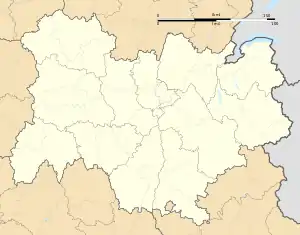Dortan | |
|---|---|
Commune | |
 Château | |
.svg.png.webp) Coat of arms | |
Location of Dortan | |
 Dortan  Dortan | |
| Coordinates: 46°19′08″N 05°39′36″E / 46.31889°N 5.66000°E | |
| Country | France |
| Region | Auvergne-Rhône-Alpes |
| Department | Ain |
| Arrondissement | Nantua |
| Canton | Pont-d'Ain |
| Intercommunality | Haut-Bugey Agglomération |
| Government | |
| • Mayor (2020–2026) | Marianne Dubare[1] |
| Area 1 | 18.11 km2 (6.99 sq mi) |
| Population | 1,953 |
| • Density | 110/km2 (280/sq mi) |
| Time zone | UTC+01:00 (CET) |
| • Summer (DST) | UTC+02:00 (CEST) |
| INSEE/Postal code | 01148 /01590 |
| 1 French Land Register data, which excludes lakes, ponds, glaciers > 1 km2 (0.386 sq mi or 247 acres) and river estuaries. | |
_en_juillet_2018_-_22.JPG.webp)
Dortan (French pronunciation: [dɔʁtɑ̃]) is a commune in the Ain department in eastern France. Besides the village of Dortan itself, the commune includes the hamlets of Uffel, Vouais, Bonaz, Emondeau, Sénissiat and Maissiat.
History
This area was settled in the first century AD by the Sequani, a Gallic people. It was on a route used by the Romans and by the seventh century, the Abbaye de Saint-Claude had been established nearby and the area was evangelized. During the feudal period in the ninth century, the counts were Lambert and Geoffroy de Dortenc, and twenty generations of these seignieres followed.[3] The Château de Dortan was built in the fifteenth century as a replacement for the original twelfth century building. It was attacked on many occasions, including by Cardinal Richelieu in 1637.[4] The last of the de Dortenc lineage was Jean-François de Dortenc, who died in 1708. He had committed various misdeeds and his successor sold the château to Pierre Gaulthier, adviser and secretary of Louis XIV. Today the château is in private ownership and is included in the list of Monument historiques.[3]
1944 massacre
In July 1944, during World War II, the Germans looted and burned the village in reprisal for activities by the French Maquis. Seven people were shot on 12 July, including the village priest and a woman. The following day, three villagers were killed and women were raped. On 20 and 21 July, 15 men were arrested and tortured at the château, which was occupied by the German troops. The next day, the remaining inhabitants were rounded up and gathered in the château while the houses in the village were burnt down. In total, 35 civilians were killed, the village was razed and only the château was left standing.[5][6]
Geography
Dortan is in the northeastern part of the department of Ain in eastern France, in the arrondissement of Nantua, 27 km from the Swiss border and 7 km (4 mi) north of Oyonnax. It lies on the river Bienne, in the western part of the Jura Mountains. The commune includes the hamlets of Uffel, Vouais, Bonaz, Emondeau, Sénissiat and Maissiat, and scattered farms. The D436 road connects the village to Saint-Claude.[7]
Population
| Year | Pop. | ±% p.a. |
|---|---|---|
| 1968 | 1,425 | — |
| 1975 | 1,445 | +0.20% |
| 1982 | 1,609 | +1.55% |
| 1990 | 2,107 | +3.43% |
| 1999 | 2,186 | +0.41% |
| 2009 | 2,059 | −0.60% |
| 2014 | 1,845 | −2.17% |
| 2020 | 1,892 | +0.42% |
| Source: INSEE[8] | ||
See also
References
- ↑ "Répertoire national des élus: les maires" (in French). data.gouv.fr, Plateforme ouverte des données publiques françaises. 13 September 2022.
- ↑ "Populations légales 2021". The National Institute of Statistics and Economic Studies. 28 December 2023.
- 1 2 "D'hier à aujourd'hui". Dortan, commune de l'Ain (in French). 7 February 2017. Retrieved 28 March 2019.
- ↑ Armand Jean du Plessis duc de Richelieu (1823). Mémoires du cardinal de Richelieu, sur le règne de Louis XIII. Foucault. p. 422.
- ↑ Kedward, H.R. (1993). In Search of the Maquis: Rural Resistance in Southern France 1942-1944: Rural Resistance in Southern France 1942-1944. Clarendon Press. p. 280. ISBN 978-0-19-159178-5.
- ↑ Farmer, Sarah (2000). Martyred Village: Commemorating the 1944 Massacre at Oradour-sur-Glane. University of California Press. p. 52. ISBN 978-0-520-22483-4.
- ↑ "Geographie". Dortan, commune de l'Ain (in French). 22 April 2014. Retrieved 28 March 2019.
- ↑ Population en historique depuis 1968, INSEE